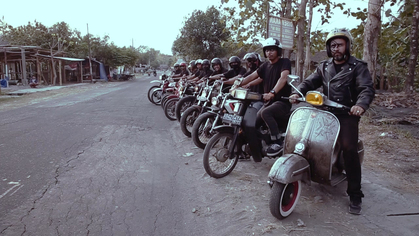-
From Current Issue
-
- Editor’s Letter Fire in the Heart
- Reviews I Gusti Ayu Kadek Murniasih
- Reviews 11th Seoul Mediacity Biennale: “One Escape at a Time”
- Dispatch Networked China
- One on One Monira Al Qadiri on Yukio Mishima
- Essays The rise of independent art spaces in pandemic-era Shanghai
- Features Tuan Andrew Nguyen
- Table of Contents
- Web Exclusives
- Archive
- Subscribe

R
E
V N
E
X
T
Engagement between Australia’s inhabitants and their near neighbors predates European contact. However since colonization, Australian artists have preferred to look to the northern hemisphere for cultural exchange. From Australian painters including John Russell and Charles Conder communing with Paris’ Impressionists in the French capital at the turn of the 20th century, to the expats who settled in London in the “swinging 60s,” and the proliferation of Australian artists who have made Berlin their home in the 21st century, the long-term trend has been to escape the antipodes and head to where the cultural action was seen to be.
However as the world globalized, so did the art sector, with a growing number of biennials and art fairs highlighting thriving art scenes in all corners of the globe. In Australia, the 1990s saw the inaugural Asia-Pacific Triennial take place in Brisbane, the establishment of Sydney’s 4A Centre for Contemporary Asian Art, and the commencement of the Asialink residency program. Over the same period, Yogyakarta in Indonesia has grown into Indonesia’s contemporary art capital. Home to a leading art school, pioneering collectives and commercial ventures, the city has launched the international careers of a number of artists. No wonder, then, that for Australian artists seeking cultural exchange abroad, Jogja has become an appealing regional alternative to Europe and North America.
The exhibition “Jogja Calling” at 4A, takes as its premise the professional and personal connections made between Australian and Indonesian artists during the course of such residencies and exchanges, and the ongoing impact of those connections on artistic practice. The show features the work of Australian artists Abdul Abdullah, Briony Galligan and Reko Rennie, alongside that of Jogja-based Leonardiansyah Allenda, Arwin Hidayat and Uji Handoko Eko Saputro, aka Hahan.
Visitors stepping off the footpath of Sydney’s busy Chinatown into 4A’s ground floor gallery are greeted by Allenda’s kinetic installation Private Numbers (2016). Various quotidian objects are freestanding or suspended from either end of numerous dowel rods, accompanied by a handwritten tag describing the significance of the item to its Australian or Indonesian owner. In a playful twist on the currently ubiquitous archival aesthetic, viewers are invited to swap the objects and attempt to balance the rods. Private Numbers is a poetic musing on the nature of relationships, and a fitting introduction to the exhibition.
The punk soundtrack to Rennie’s video work Warriors Come Out to Play (2014) forms an aural backdrop to the works in 4A’s first floor gallery space. The video features a motorcycle gang, including Rennie and fellow “Jogja Calling” artist Hahan, replete with warpaint. Rennie’s hard-edged iconographic style, which draws on his Kamilaroi Aboriginal heritage, echoes the pop-cultural iconography often employed by Hahan in his recent paintings. For this exhibition, however, Hahan, like Rennie, highlights identity politics in an installation titled Welkome Mate (2012), where he performs as an anonymous traveler depicted at Australian air and sea arrival points, wrapped in a blanket emblazoned with the work’s title phrase, carrying battered old suitcases. These objects are presented in the gallery alongside a Persian rug, perhaps a prayer mat. Hahan feels the Australian art world has put out the welcome mat for him and the work is intended to celebrate its positive impact on his practice. However, one could not help but read these images in the context of the current political climate, with movements across borders hindered by cruel policy, and welcomes not always being warm. The contrast between the ragged edges of the blanket’s lettering and Rennie’s proud, sharply-rendered Crest (2014) is marked.
Both Hidayat and Abdullah employ traditional techniques in their suspended banners that face off in the space. While Adbullah’s embroidered works Don’t Worry and Be Happy (both 2016), with grinning fluorescent emojis overlaying tonally segmented portraits, interrogate contemporary visual culture, Hidayat’s classical Indonesian motifs, with contorted figures, mythological creatures, and Bosch-like confluence of sex and death rendered in batik, are the more evocative.
In contrast to the figurative works of these artists, Galligan, like Allenda, has used the absence of figure to create a more contemplative experience. An ethereal revolving door constructed of fabric captures lines from a poem projected from a slide carousel. From the facing wall emerge wooden hands caught mid-gesture (these were carved by Lajar Budiharo in Jogja’s Carving Arts Studio based on drawings by Galligan). The work, Door-to-Door (2015), is a fitting encapsulation of the emotional slippages that can occur in relationships.
Rather than capturing a succinct Australian-Indonesian tendency, “Jogja Calling” showed a variety of tonalities, and the varied impacts of cross-cultural exchange on artistic practice. While New York, once the center of the art universe, contorts in the aftermath of Donald Trump’s ascendancy to the highest office, some Australian artists are looking to establish connections elsewhere—in this case our northern neighbor, the world’s most populous Muslim majority country. From that perspective, “Jogja Calling” is a reminder of the value of these connections in what seems to be an increasingly divided world.
“Joja Calling” is currently on view at 4A Centre for Contemporary Asian Art, Sydney, until December 17, 2016.
To read more of ArtAsiaPacific’s articles, visit our Digital Library.







